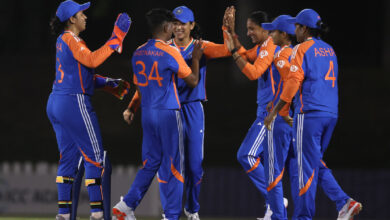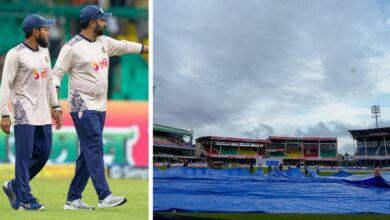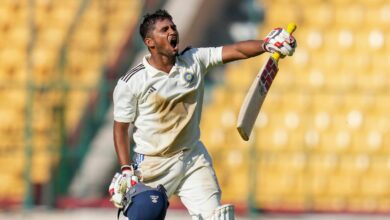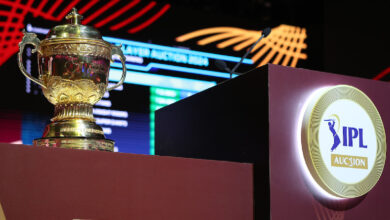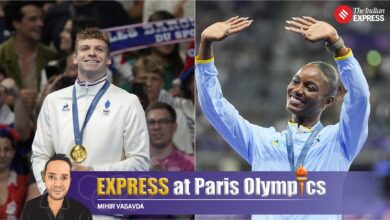More and more Indian table tennis players are using long pimple rubbers. But does it guarantee success? | Sport-others News

After she returned empty-handed from the Birmingham Commonwealth Games three years ago, a draught Manika Batra returned to the drawing board. Old associations were rekindled. And old ways were rejigged.India’s top women’s table tennis player called on her old friend Aman Balgu, who runs an academy in Hyderabad. Not a fan of the pimpled rubber Manika used, Balgu kept an open mind and saw the benefits of it. But to make it work, he made a subtle, yet profound, tweak.
“Manika came to me when she was already a well-established player. She was taught and ingrained in her that the pimpled rubber is a defensive rubber, and the only way she can attack is to twiddle and smash,” Balgu tells The Indian Express. “My idea was very simple, why use the backhand to just defend or just control the pace of the game? Why not use it to be aggressive?”
That laid the foundation for a change in Manika’s style. “We’ve been able to beat top-20 players like World No. 5 Hina Hayata and World No. 11 Cheng-I-Ching but we need to do so more consently. The whole part of evolving is adding new weapons to your game,” Balgu says.
Last week, at the WTT Star Contender tournament in Goa, five of the six Indian women paddlers in the main draw used long pimples on the backhand. A couple of them used the same rubber at the Asian Games last year, too. All of them were inspired Manika’s approach, which helped her finish on the podium at the CWG six years ago.
To them, it didn’t matter that the time the next Games arrived, Manika’s game was sorted out her opponents. But as their results plateau – further reinforcing the fact that the long-pimpled rubbers invariably trigger second-season blues – there are growing concerns over the viability of the strategy.
“Just looking at the success that Manika and Sreeja (Akula) are having, youngsters nowadays will want to use the pimpled rubber,” says Sreeja’s coach Somnath Ghosh, who runs his academy in Hyderabad. “It is my biggest concern.”
***
The ‘long pimple’, is a rubber covered with conical-shaped bumps or thin and tall pips. Seen as a largely defensive rubber, when the ball comes in contact with it, the pips bend and put the opposite effect on the spin the ball came with. The shot simply goes back with the opposite spin regardless of whether it’s played with a topspin or backspin motion.
While Manika has proven that it can get results against top players, Indian paddlers have yet to be consent at the top. There are eight women in the top 200 of world rankings with only three of them in the top 100. Incidentally, the three in the top 100 – Manika, Sreeja Akula, and Yashashwini Ghorpade — all use long pimples.
But just like Manika – who was able to confuse her opponents in Jakarta but in Birmingham, it seemed like her opponents had figured her out – the rest, too, struggle against top players, who have understood how the rubber works.
The top players have also realised that it was just a passive rubber and they could use their tireless attacks to tire out the opponent. It’s essentially why Manika and no Indian have entered even the top 30 of world rankings.
“Coaches who are not bothered about their wards coming into the top 30 of the world rankings will encourage it. They are just happy with them doing well at the national well. But they don’t see Sreeja’s or Manika’s game,” Ghosh says. “They think that just putting the pips they are getting points, but it’s not true. They don’t get that many points with long pips. Sreeja gets most of her points attacking with the forehand, Manika twiddles.”
***
Long before Manika made the rubber famous, it was Neha Aggarwal Sharma who first ventured into territory unknown, and started to use the rubber that not many Indians used or rather, knew how to.
Back in 1998, as an 8-year-old, Neha was asked her coach, the renowned Sandeep Gupta, to try out playing with a pimpled rubber on her backhand. Not one to question her coach, she agreed and together they went about on a journey of figuring out what exactly the long pips are capable of doing, how best to use it and what are the limitations of using it.
They even went to Switzerland for an eight-day camp with Dr Herbert Neubauer, largely considered the pioneer of this rubber and whose equipment the top players use today. Out there, he taught them the intricacies of the rubber and “added more weapons to the game,” as Neha puts it.
“When I started using it, I was seen almost as an outcast,” Neha tells this newspaper. “It became even more difficult when I was in the national team and the coaches didn’t know about it. There were times at the national camp when I would just play with another bat. I even stopped playing with it for some time when the results were not going my way.”
the time Manika joined Gupta’s training centre in Delhi as a youngster, Gupta had to a large extent, figured out what all the rubber could do and realised it could be put to best use only if the player had a powerful forehand. One of the key weapons that Gupta was able to teach both Neha and Manika was ‘twiddling’, something that Manika has now made famous.
“We used the pimpled rubber to reduce the speed of the ball and then change the grip mid-rally and use the plain side to attack. The shock effect of this variation confuses the opponents and gives us the point,” Gupta explains.
However, barring Manika and to an extent, Sreeja, no Indian who currently plays with long pips has been able to do well and remain consent mostly because top players can easily sort out the playing style of those who use these rubbers.
Being a passive rubber, the long pimples are generally used players to defend. It gets extremely difficult against top players who are unrelenting and tireless with their attacks.
“We’ve always been passive and wait for the opponent to make a make. What if they don’t make a make? We shouldn’t be waiting for them to make a make,” says Manika’s coach Balgu. It was this thought on which the idea that Manika should use her defensive rubber to attack, took flight.
“Now, we may be losing against lower-ranked players which would never happen earlier but at the same time, we’re also beating the top players which we also never did. The ultimate goal is beating the top Asians, the Chinese especially, right? How do you do that if you don’t have something in your bag to threaten the opponent,” Balgu adds.
The wins over top-20 players give them hope that they are in the right direction. “The whole part of evolving is adding new weapons to your game,” Balgu says.
***
As more and more Indian players turn to these rubbers, it gives rise to a question: is the potential upswing purely because of the equipment or has Indian TT indeed taken a giant stride?
Ghosh, Sreeja’s coach, points to the fact that the reason China is the gold standard in international table tennis is because the players there are taught the same basics in all parts of the country.
“In India, 10 players have 10 different actions but in China, 1000 players have the same action. You will only see a minor tweak in their action. In India, different coaches in different parts of India have different schools of thought and teach the basics differently. We need a national centre where not only the youngsters but the coaches are also coached.”
Before India can have a centralised coaching programme, they need to figure out which is the right way to go. Go pimpled or fast?
Balgu, who has played with fast rubbers all his life, says that if used properly, the pimpled rubbers could well make India a powerhouse.
“We have this rubber, it’s capable of much more than we ever thought. And we’re yet to figure out everything it’s capable of doing. We’ve got a headstart. If the other aspects of a player’s game can complement it, India can become a powerhouse. We have an advantage as others don’t try to play with it.”
It’s almost as if Balgu is reading out the verdict on the long-standing debate. In reality, though, the jury is still out.
What do long pimples do?
Produces the opposite Spin. The space between two pimples gives the ball a wobbling effect. The surface of the rubber has less friction. The balls are played much flatter on the net and has less arch when it goes on the other side of the table. Players generally use no sponge under the rubber. No sponge makes the rubber slower.
Players who use long pips:
1. Linda Bergstorm of Sweden WR 29 (defender)
2. Manika Batra WR 36
2. Xia Lian Ni of Netherlands WR 41
3. Sreeja Akula WR 51
5. Suh Hyo Won of Korea WR 53 (defender)



